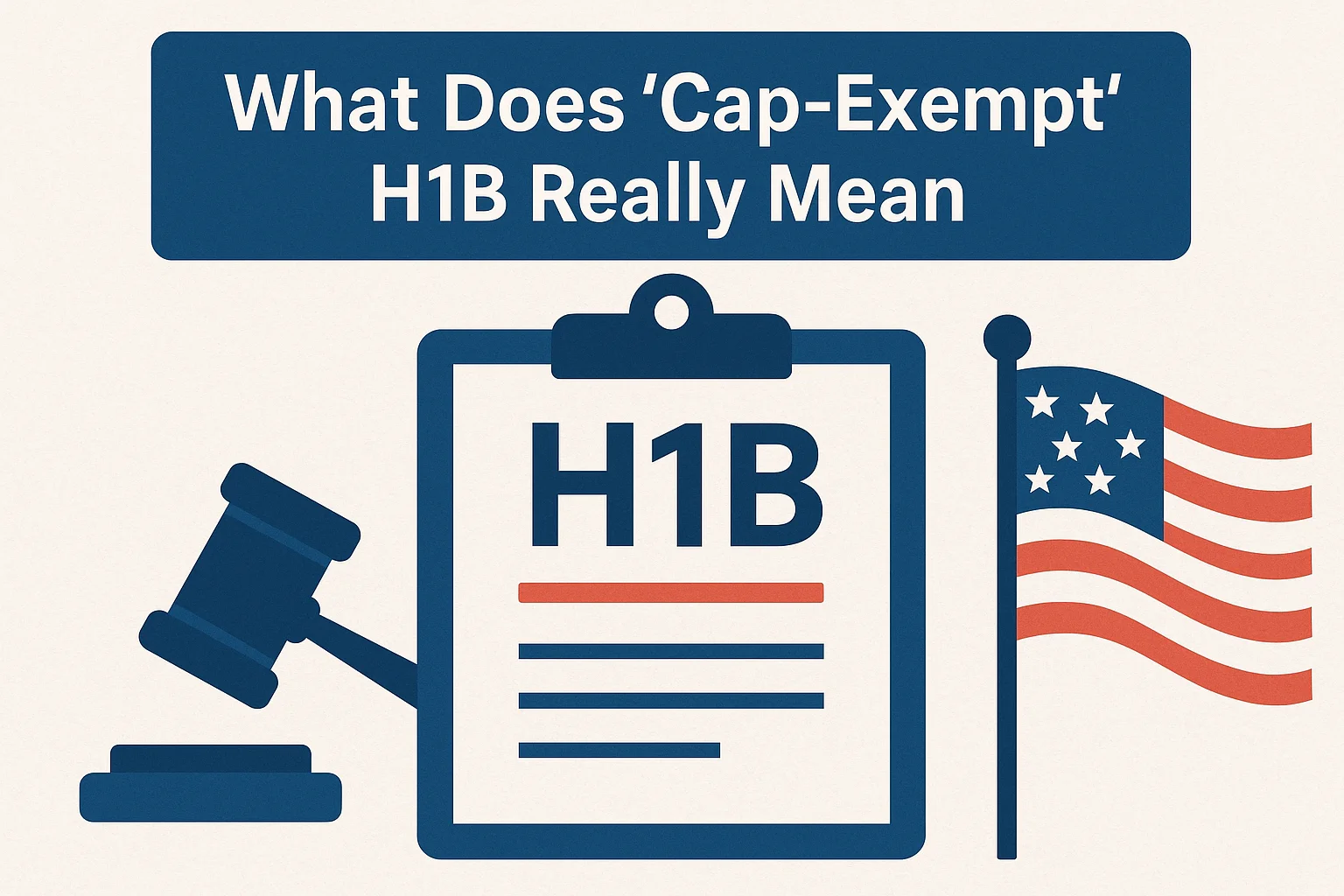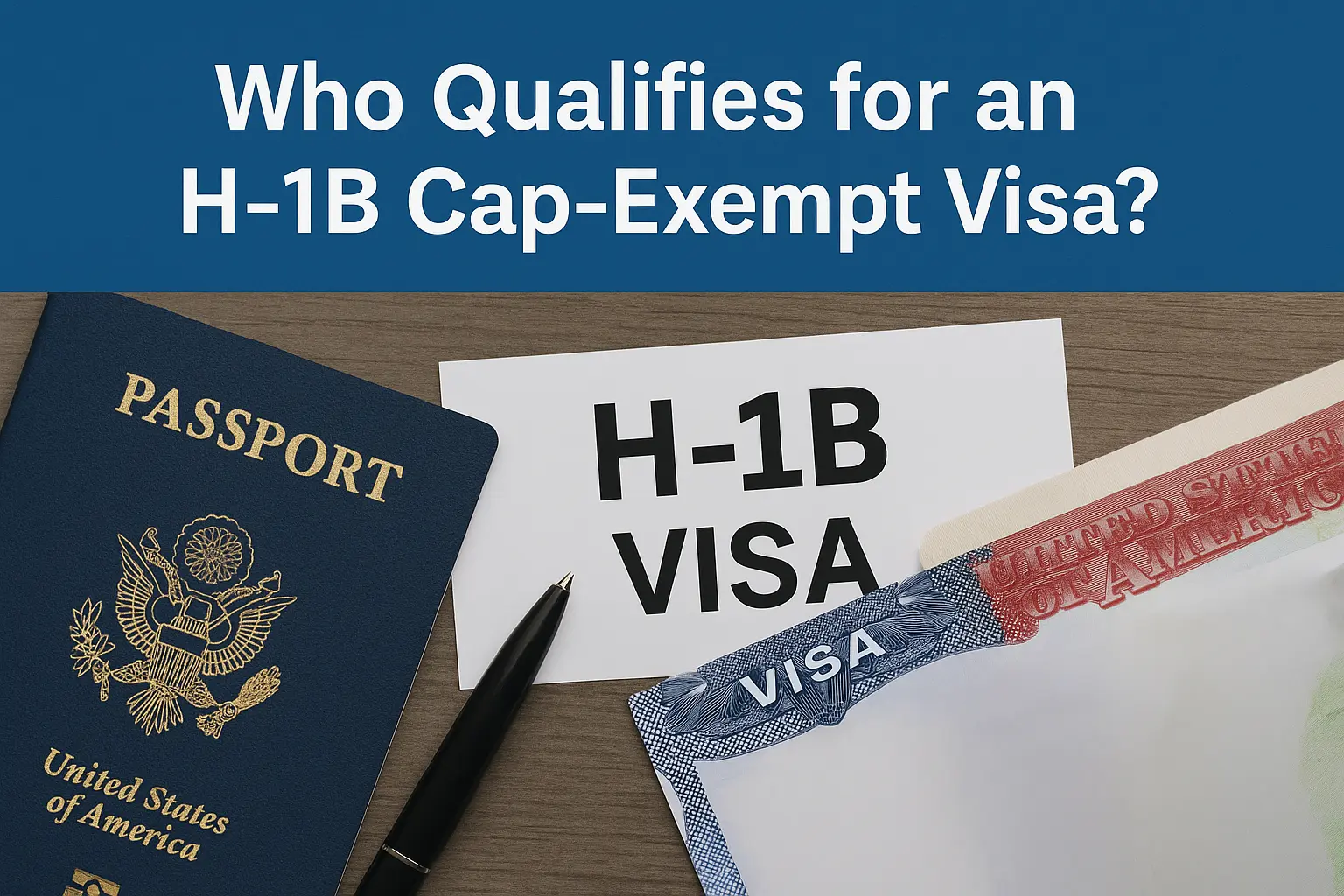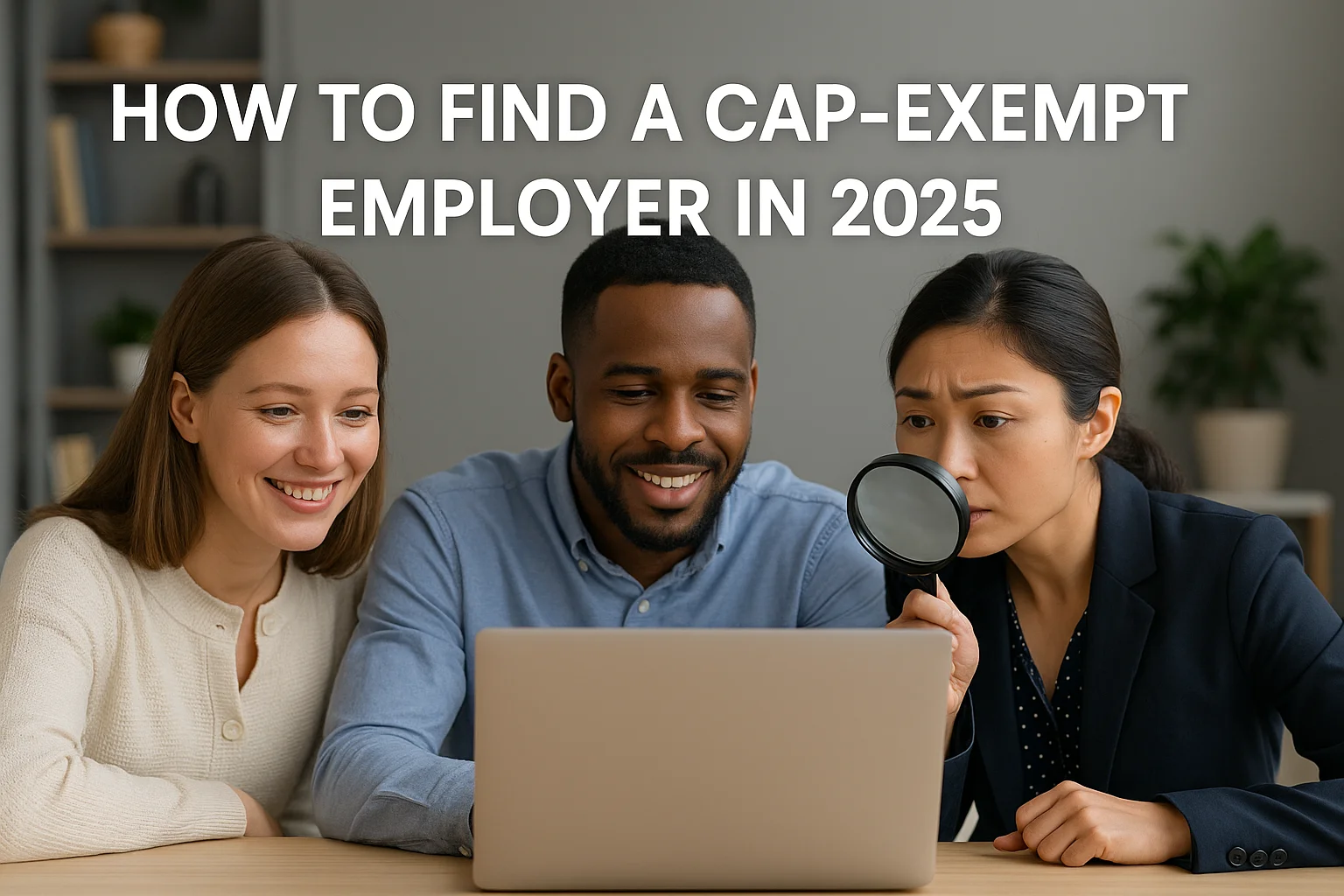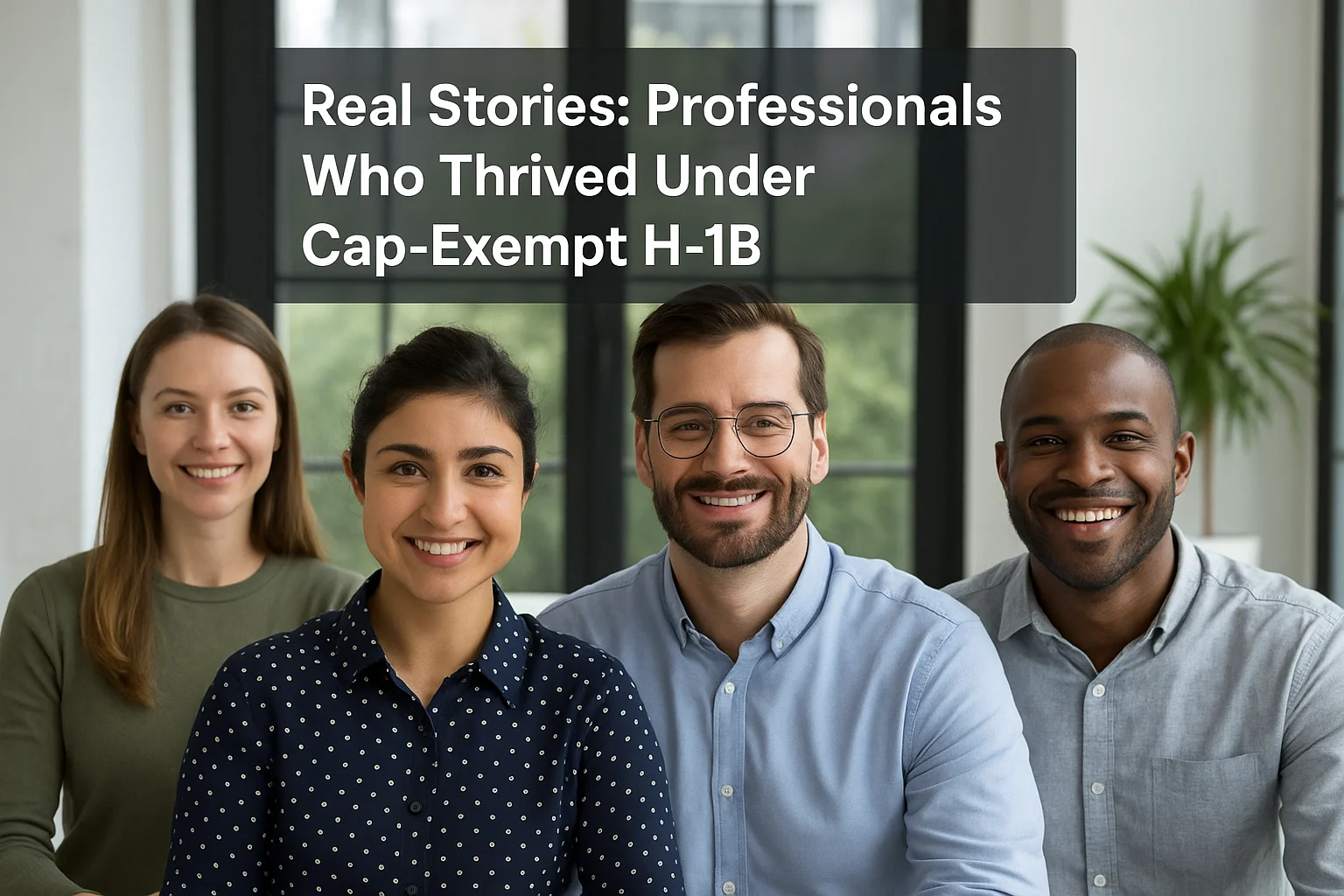Imagine getting the chance to work in the U.S. on an H1B visa—without ever having to cross your fingers for a lottery result. Sounds impossible, right? Nope. It’s called the H1B Cap-Exempt pathway, and it’s one of the best-kept secrets in the U.S. immigration playbook.
Here’s a wild stat: In 2024, nearly 500,000+ H1B registrations were submitted for just 85,000 spots. That means less than 1 in 5 applicants even got a chance to be considered. But here’s the twist—not every H1B job is subject to this lottery. Some organizations can hire you anytime. No caps. No lotteries. Just straight-up petitions and approval.
If you’re a researcher, healthcare worker, university lecturer, or even a STEM graduate stuck in Optional Practical Training (OPT) limbo, this might be your golden ticket. In this article, we’ll unpack exactly what a cap-exempt H1B is, who qualifies, how to land one, and why it might be the smartest immigration move you make in 2025.
Let’s break it down together—you might be closer than you think!
🟦 What Does “Cap-Exempt” H1B Really Mean?

Okay, so let’s get the basics straight. You’ve probably heard the term “H1B lottery” a million times. That’s because the standard H1B visa process is capped—literally. There’s a numerical limit each fiscal year, and the USCIS runs a random lottery to select who gets in. Not exactly comforting when your future’s at stake, huh?
Now here’s where the cap-exempt category comes in and saves the day.
A cap-exempt H1B is a type of visa petition that doesn’t count toward the annual cap (which is 65,000 regular slots + 20,000 for master’s degree holders in the U.S.). This means eligible employers—like universities, nonprofit research institutions, and some government agencies—can file your H1B any time of year. No need to wait for April. No praying to the immigration gods for a lottery win. Nada.
I once worked with a guy—smart PhD in environmental science—who thought he was stuck after two failed lottery attempts. He landed a teaching position at a state university, applied through the cap-exempt route, and bam, he got approved in weeks.
It’s not a loophole; it’s just a different track. Cap-exempt doesn’t mean easier, but it definitely means more predictable.
TL;DR:
- Cap-subject H1B = Lottery-based, limited to 85,000 per year.
- Cap-exempt H1B = No lottery, unlimited hiring dates, specific employer types.
- Eligibility is tied to the employer, not the job title or the person.
So if you’re targeting those employers, you’re already ahead of the game. Let’s move on to who qualifies—and how you can find them.
🟦 Who Qualifies for an H1B Cap-Exempt Visa?

Now that you’ve got the basics, let’s talk eligibility—because not every job or employer can offer a cap-exempt H1B. And this is where people often trip up. It’s not about what you do… it’s about who you work for.
So, who’s in the cap-exempt club?
🏛️ 1. Institutions of Higher Education
Think universities, colleges, community colleges—basically any accredited post-secondary school. These places are always cap-exempt. Whether you’re a professor, researcher, or even a software engineer supporting the school’s IT department, you could be eligible.
I knew someone who got hired as a data analyst at a university’s public health department—not faculty, not a PhD, just highly skilled. Still counted as cap-exempt. Wild, right?
🧪 2. Nonprofit Entities Affiliated with a College or University
Here’s where it gets tricky—but also super useful. Some nonprofits are legally connected to universities. That could be a teaching hospital, a lab, or even a think tank that partners with a school.
The key word? “Affiliated.” If the organization can show a close connection (usually through contracts, shared resources, or oversight), they can often sponsor cap-exempt H1Bs.
🧬 3. Nonprofit Research Organizations
These are entities whose main purpose is research—in medicine, science, tech, whatever. They need to be designated as nonprofit under IRS rules, and their work must benefit the public. These orgs can file cap-exempt H1Bs year-round.
We’re talking places like national research institutes, STEM nonprofits, and even think tanks. If you’ve got a strong academic or research background, you’re in luck.
🏥 4. Government Research Organizations
Yep, Uncle Sam’s got a spot for you too—well, maybe. Federal, state, and local agencies that do research can also be cap-exempt. Think NIH, CDC, and sometimes state universities or labs.
Now here’s a fun twist…
🔁 5. Concurrent Employment Situations
Let’s say you already have a cap-subject H1B with a private company. If you also pick up a second job with a cap-exempt employer, that secondary role can be processed outside the cap. That’s called concurrent employment, and it can be a clever workaround to gain more flexibility.
Just remember—it’s the employer’s status that matters, not yours. Even if you’re super qualified, you can’t go cap-exempt unless your employer fits into one of the categories above.
🟦 Benefits of the Cap-Exempt H1B Route
Okay, so you now know that not all H1Bs are created equal—and cap-exempt H1Bs? They come with some pretty sweet perks. This isn’t just a “Plan B”—for a lot of people, it’s actually the smarter move.
Let me walk you through why.
🗓️ 1. No Lottery, No Stress
This one’s the obvious winner. With a cap-exempt H1B, you can skip the nerve-wracking lottery process altogether. You don’t have to wait for that one April window like everyone else and hope your name gets drawn from a digital hat.
It’s like skipping the line at Disneyland—everyone’s sweating it out in the queue, and you just waltz right in.
🕒 2. Apply Year-Round
Seriously, no deadlines. That means your employer can file your petition at any point during the year. I had a friend who got her university offer in October and started working by January. That would’ve been impossible under the regular cap-subject route.
If you’re transitioning from OPT or just missed this year’s cap, this flexibility is a lifesaver.
⚡ 3. Faster Processing Times (Sometimes)
Cap-exempt petitions often get processed quicker—not because of a special lane, but because they avoid the massive April rush. You’re not competing against half a million other filings clogging up the system.
🧘 4. Job Stability and Renewals
Cap-exempt positions tend to be in fields like education, medicine, and research—all of which have more stable funding and less volatile hiring practices. You’re less likely to face sudden layoffs, and many of these roles are easier to extend or renew.
Bonus: these organizations often have better legal support for visa renewals, green card sponsorships, and even J-1 to H1B transfers.
🤝 5. Path to Green Card Might Be Smoother
A lot of cap-exempt employers are well-versed in immigration processes. They’re used to sponsoring international employees and often have systems in place to handle PERM and I-140 processes more smoothly. That means if you’re planning long-term, this could be your golden pathway.
So, bottom line? If you qualify for a cap-exempt H1B, you’re not just avoiding the lottery—you’re stepping into a system that’s less chaotic, more supportive, and often much faster.
🟦 How to Find a Cap-Exempt Employer in 2025

So you’re sold on the cap-exempt path—awesome! Now comes the real question: Where the heck do you find these unicorn employers?
Well, good news: they’re not as rare as you might think. You just need to know where to look—and how to tailor your job search to spot them.
🧭 1. Target the Right Types of Institutions
Start by focusing your job hunt on:
- Universities and colleges (public or private)
- Nonprofit hospitals (especially teaching hospitals)
- Scientific or medical research institutions
- Think tanks and public policy organizations
- Government-funded labs
These organizations are the core of the cap-exempt ecosystem. If they’re hiring, chances are they already know how H1B sponsorship works—and many of them are actively looking for international talent.
🔍 2. Use Smart Search Keywords
Here’s a little trick: when searching on platforms like LinkedIn, Indeed, or HigherEdJobs, include terms like:
- “H1B sponsorship”
- “cap exempt”
- “nonprofit eligible”
- “research associate university”
- “teaching hospital career”
You’d be surprised how many listings casually mention cap-exempt eligibility in the fine print.
Pro tip: try using Google search operators, like:
higheredjobs.com “h1b cap exempt” biology
Trust me, this works way better than generic job hunting.
🤝 3. Tap into Academic Networks
Academic circles are smaller than you think. If you’re a grad student or postdoc, talk to your advisors, professors, or department heads. These folks often have insider info about hiring labs, open roles, and contacts in cap-exempt institutions.
Even alumni networks can be goldmines. I once messaged an alum I hadn’t spoken to in three years, and she helped me land an interview at a cap-exempt research center. People love helping people who show initiative.
📬 4. Email the HR Department Directly
When in doubt, just ask. A quick email to the HR or immigration office at a university or research institution can clear things up fast. Ask:
- “Do you offer H1B cap-exempt sponsorship?”
- “Is this position affiliated with a nonprofit or higher ed institution?”
Don’t be shy. Better to know early than waste time on a job that can’t legally hire you.
🎯 5. Watch for Affiliations
Some private organizations partner with universities in research or education—and that might make them cap-exempt. Always read the job description and look for phrases like “affiliated with XYZ University” or “in collaboration with.”
If you see that? Dig deeper—it might be a backdoor into the cap-exempt club.
Bottom line: finding a cap-exempt job is all about strategy. Know where to look, ask the right questions, and don’t settle for vague job posts. The opportunities are out there—you just have to go get ’em.
🟦 Application Process for Cap-Exempt H1B Jobs

Okay, so you’ve found your dream cap-exempt job—now what? The good news? The application process is almost identical to the regular H1B. The great news? You don’t have to wait until April or cross your fingers for a lottery draw. 🙌
Still, there are steps. And trust me, missing one can delay or tank your petition. Here’s the full breakdown, step by step:
📝 1. Labor Condition Application (LCA)
First, your employer has to file an LCA (Form ETA-9035) with the U.S. Department of Labor. This ensures they’re offering a wage that meets or exceeds the prevailing wage for your role in the job’s geographic location.
It’s not a complicated form, but it has to be filed and approved before moving forward. Processing usually takes around 7 business days.
🟡 Tip: Make sure the job title and description on the LCA match your petition exactly. USCIS gets picky.
📤 2. Filing the I-129 Petition
Once the LCA is certified, your employer submits Form I-129 to USCIS, along with:
- Proof of the employer’s cap-exempt status (nonprofit, university, etc.)
- Your educational credentials
- A detailed job description
- Your résumé and relevant licenses, if any
- Filing fees (which your employer typically covers)
If your case is solid and documentation is clean, this part can go smoothly. But if USCIS wants clarification, they’ll send a Request for Evidence (RFE)—which can delay things.
🎯 Pro tip: Premium Processing is available for most cap-exempt H1Bs, which means a 15-day decision window once the form is accepted.
📆 3. Approval and Status Activation
Once approved, you’ll receive Form I-797, your official approval notice. If you’re already in the U.S., you can start working on the start date listed in the petition.
If you’re applying from abroad, you’ll need to schedule a visa interview at your local U.S. embassy or consulate. Bring your I-797, passport, DS-160 confirmation, and other supporting docs.
🛬 After visa stamping, you can enter the U.S. up to 10 days before your official start date.
🔁 4. Transfers Within Cap-Exempt Jobs
Want to switch jobs to another cap-exempt employer? You’re good to go—as long as the new employer also qualifies under the cap-exempt category. Just repeat the process above with the new institution.
But if you’re going from cap-exempt to cap-subject? Different story. (We’ll get to that in the next section.)
Cap-exempt doesn’t mean “easy”—but it does mean fewer roadblocks. With a clear roadmap and a diligent employer, you could be up and working in just a few months, regardless of the calendar.
🟦 Common Mistakes and Misunderstandings to Avoid

Alright, real talk: cap-exempt H1Bs are amazing, but only if you navigate the system right. Unfortunately, a lot of people mess up—not because they’re careless, but because the rules are weirdly specific and often misunderstood.
Let’s save you the stress and go over the most common pitfalls you’ll want to avoid:
❌ 1. Assuming All Nonprofits Are Automatically Cap-Exempt
This is the #1 misconception—just because an employer is nonprofit doesn’t mean they’re cap-exempt. The organization must either:
- Be a recognized nonprofit affiliated with a university, or
- Qualify as a nonprofit research organization (per IRS and USCIS standards).
A small nonprofit with no ties to education or research? Probably not cap-exempt. Always ask.
🟡 Tip: Ask the employer, “Do you have experience sponsoring cap-exempt H1B petitions?”
❌ 2. Ignoring the ‘Affiliation’ Requirement
Let’s say you’re applying to a nonprofit hospital. Sounds cap-exempt, right? Not always.
If the hospital isn’t formally affiliated with a university—like having shared control, funding, or educational programs—it won’t qualify. This is where USCIS gets technical.
So don’t just go by the name. Look for proof of legal affiliation with an institution of higher education.
❌ 3. Relying on Job Titles Alone
Your title doesn’t make you eligible. You could be a brilliant professor—but if you’re working at a for-profit education startup? You’re not cap-exempt.
Cap-exempt status is 100% about the employer’s legal category, not your role or credentials.
❌ 4. Thinking You Can File Anytime With Any Employer
This one’s sneaky. Yes, cap-exempt jobs can be filed year-round—but only if the employer qualifies. Don’t get tricked into thinking “year-round H1B filing” applies to everyone.
Cap-subject employers? You’ll still have to wait for the annual April window and hope for lottery selection.
❌ 5. Forgetting Location-Specific Compliance
Let’s say your job is at a university, but your actual worksite is off-campus or at a third-party site. That could cause issues—especially if USCIS decides the job doesn’t meet the required cap-exempt criteria for that location.
🟡 Fix: Make sure your employer files a proper LCA that accurately reflects your work location and confirms it’s still covered by cap-exempt rules.
Avoid these mistakes, and you’re already 10 steps ahead of most applicants. Immigration rules can feel like a maze—but with the right info, you’ll be able to spot red flags and make smart moves confidently.
🟦 Real Stories: Professionals Who Thrived Under Cap-Exempt H1B

Let’s face it—immigration can feel like a never-ending uphill climb. But every now and then, you meet people who beat the odds, not because they were lucky… but because they found the right path. Cap-exempt H1Bs have been that path for so many folks—maybe even someone just like you.
Here are a few real-world examples to remind you it can work out.
🎓 Amira – Assistant Professor at a Liberal Arts College
Amira, originally from Egypt, completed her PhD in Comparative Literature in the U.S. After her F-1 visa ended, she was terrified of falling out of status. Luckily, she got a job at a small liberal arts college in the Midwest. The college filed a cap-exempt H1B for her in December—no lottery, no wait.
Within 60 days, she was teaching full-time. Three years later? She’s on track for a green card through her university’s EB-2 process.
“Honestly, I didn’t even know ‘cap-exempt’ was a thing until my HR told me. Best surprise ever.”
🧪 Harish – Postdoc at a Research Institute
Harish was finishing up his STEM PhD and had been rejected twice in the H1B lottery. It was brutal. But instead of giving up, he applied for a postdoctoral position at a nonprofit research institute affiliated with a major university.
Because the institute was cap-exempt, he finally got the visa—without waiting another year. Now he’s publishing research in top journals and already thinking about applying for an EB-1 green card.
“I went from being stuck to thriving in literally four months.”
🏥 Maria – Nurse at a Teaching Hospital
Maria was working as an RN in the Philippines and had always dreamed of working in the U.S. She applied to several hospitals, but only one—a university-affiliated teaching hospital in New York—was able to sponsor her through a cap-exempt H1B.
She moved, got her visa approved in under 90 days, and started working in pediatric care.
“Everyone said getting to the U.S. was impossible unless you were in tech. Nope. Healthcare’s a game-changer.”
💡 What These Stories Teach Us:
- Cap-exempt roles are real and attainable if you know where to look.
- Timing matters—they all filed outside the traditional April window.
- Your degree can open more doors than you think, especially in education and research.
- You don’t have to be in tech to succeed on an H1B.
These aren’t unicorn stories—they’re happening every day. Cap-exempt jobs are out there, and the people landing them? They were just like you… until they made the move.
🟪 Conclusion: Your Roadmap to a Cap-Exempt H1B in 2025
Let’s be honest—navigating the U.S. immigration system can feel like trying to solve a puzzle with missing pieces. But if there’s one thing this guide should prove, it’s this: you don’t have to rely on the H1B lottery to build your future in the U.S.
The cap-exempt H1B route is one of the most powerful—and most overlooked—pathways available in 2025. Whether you’re in academia, healthcare, research, or a related field, there’s a way in. You just need to:
- Target the right employers
- Understand the rules and benefits
- Avoid common mistakes
- Apply strategically—any time of year
With the right approach, you could be working, thriving, and even planning your green card without ever entering a lottery. That’s a game-changer.
Remember, you’re not stuck. You’ve got time, tools, and talent—and now, a roadmap. So go chase the role you deserve. The U.S. needs people like you—skilled, driven, and ready to contribute.
✨ If this guide helped you, share it with a friend who’s feeling stuck in the lottery grind. Let’s lift each other up.
🔍 Further Reading: Explore More on Cap-Exempt H1B Visas
-
USCIS: H-1B Cap-Exempt Employers Overview
Official explanation from USCIS about cap-exempt eligibility and definitions.
👉 https://www.uscis.gov/working-in-the-united-states/temporary-workers/h-1b-specialty-occupations-and-fashion-models/h-1b-cap -
USCIS Policy Manual: Cap-Exempt Definitions and Employer Types
In-depth breakdown from USCIS policy guidance on who qualifies as a cap-exempt entity.
👉 https://www.uscis.gov/policy-manual/volume-2-part-m-chapter-6 -
Department of Labor: Labor Condition Application (LCA) Info
Everything you need to know about ETA Form 9035 and how prevailing wage is determined.
👉 https://flag.dol.gov/programs/h-1b -
NIH: Cap-Exempt Jobs in Government Research
Check out real cap-exempt opportunities with government-affiliated research institutions.
👉 https://www.training.nih.gov/career_services/jobs -
HigherEdJobs: Search for Academic and Cap-Exempt Roles
A great platform for finding university and affiliated nonprofit positions.
👉 https://www.higheredjobs.com -
American Immigration Lawyers Association (AILA) Resources
If you’re looking to understand immigration policy changes or get expert insights.
👉 https://www.aila.org/advo-media/issues/all/h-1b-visa-program -
Study in the States: Transitioning from OPT to H1B Cap-Exempt
Helpful for F-1 students navigating the post-graduation job maze.
👉 https://studyinthestates.dhs.gov/2018/03/h-1b-cap-gap-extension-what-it-is-and-who-qualifies -
NAFSA: Academic Immigration Sponsorship Explained
Learn how institutions of higher education handle cap-exempt petitions.
👉 https://www.nafsa.org/professional-resources/browse-by-interest/employment-h-1b-temporary-worker-status -
VisaJourney: Real Stories & Case Timelines
Peer-shared case timelines and cap-exempt experiences.
👉 https://www.visajourney.com/forums/forum/133-h1b-h2b-h3-visas/
